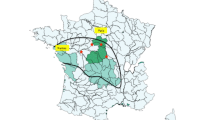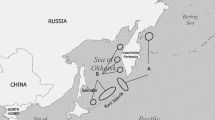Abstract.
Eight commercially and recreationally important marine species were collected in 1993 and 1994 from several Atlantic and Pacific coastal regions of the contiguous United States. Approximately 700 edible tissue samples (e.g., whole body of mussel, crustacean muscle and hepatopancreas, and fish muscle) were analyzed for dioxin-like chlorobiphenyls (CBs) and other selected CB congeners using a rapid high-performance liquid chromatography photodiode array detection method (HPLC/PDA). Total CBs and toxic equivalents (TEQs) of dioxin-like CBs were also determined. The most abundant congeners measured in these tissues were the moderately chlorinated CBs (e.g., CB 138, 153), with mean concentrations ranging from below the limits of detection (approximately 0.2 ng/g) to 1,500 ng/g, wet weight. Certain dioxin-like CBs (e.g., CBs 77, 105, 118, 126) were also found in several of these samples (mean concentrations ranging from below the limits of detection [approximately 0.4 ng/g] to 680 ng/g). Similar to previous studies, the majority of seafood tissues contained total CB concentrations that were below the U.S. Food and Drug Administration's (FDA) tolerance limit for CBs of 2,000 ng/g, wet weight (2.0 ppm). Furthermore, the majority of samples that contained CB levels below the FDA CB tolerance limit also had CB TEQs that were lower than the FDA's advisory level for TCDD (25 ppt or 25 pg/g, wet weight) in fish from the Great Lakes, which is used in evaluating CB TEQs. Several crustacean hepatopancreas samples collected from certain Atlantic and Pacific urban sites (e.g., Dungeness crab from Elliott Bay in Puget Sound, WA, American lobster from Deer Island in Boston Harbor, MA), however, did contain total CB and CB TEQs that exceeded the FDA CB tolerance and TCDD advisory limits. Mono-ortho- (e.g., CBs 118, 105) and non-ortho-substituted congeners (e.g., CBs 77 and 126) were the largest contributors to the CB TEQs of the hepatopancreas samples that exceeded the action limit.
Similar content being viewed by others
Author information
Authors and Affiliations
Additional information
Received: 27 July 1998/Accepted: 13 December 1998
Rights and permissions
About this article
Cite this article
Ylitalo, G., Buzitis, J. & Krahn, M. Analyses of Tissues of Eight Marine Species from Atlantic and Pacific Coasts for Dioxin-Like Chlorobiphenyls (CBs) and Total CBs. Arch. Environ. Contam. Toxicol. 37, 205–219 (1999). https://doi.org/10.1007/s002449900507
Issue Date:
DOI: https://doi.org/10.1007/s002449900507




